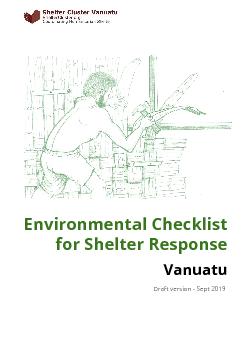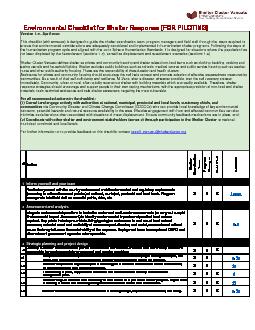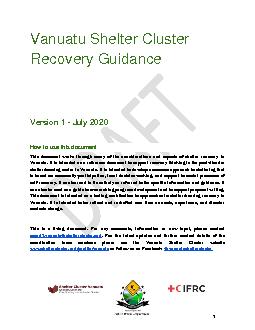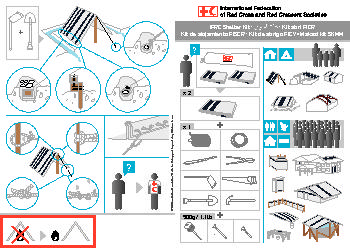
Under the leadership of the Public Works Department (PWD), the Shelter Cluster is formed by Government and non-Government member agencies with expertise, activities, stakeholders, and resources in the area of shelter, which can provide assistance in disaster preparedness and response.
Member organisations consist of Government agencies, UN agencies, Red Cross, donors, local and international non-government organisations (NGOs), and civil society groups involved in shelter. Some member organisations only have a presence in Vanuatu during disaster response, but will be kept informed of cluster activities, meetings and decisions electronically and through the Vanuatu Shelter Cluster webpage.
During the TC Pam response, more than 30 partners were involved in the provision of shelter assistance; current active shelter cluster partnership includes the National Disaster Management Office (NDMO), Vanuatu Red Cross Society (VRCS), Care International, Save the Children, Adventist Development Relief Agency (ADRA), World Vision, Butterfly Trust, Vanuatu Council of Churches (VCC), the International Organization for Migration (IOM), Provincial Governments, Customary Land Management Office, Direction of Local Authorities (DLA), Lands Department, and representatives from other clusters.
The International Federation of the Red Cross and Red Crescent Societies (IFRC), as convener of the Pacific Shelter Cluster (as a part of the Pacific Humanitarian Team), is also a member of Vanuatu shelter cluster, and as co-lead, provides support to PWD during preparedness and response. During a disaster response, the IFRC provides surge coordination capacity as requested by the Lead Agency, to the extent required and possible within available resources.
Objectives of the Shelter Cluster
The objective of the Shelter Cluster is to plan and implement proportionate, appropriate and timely shelter responses in humanitarian crisis situations which address immediate to long term shelter needs of the vulnerable affected populations, while focussing at the same time on the integration of disaster risk reduction activities. The Shelter Cluster works towards these objectives:
- Coordinate the shelter related activities and programs among members related to disaster preparedness and response.
- Ensure that the cluster has the tools and information to implement a coordinated approach to shelter related disaster preparedness and response activities.
- Ensure that during disaster response, humanitarian shelter needs are identified and strategy is defined for appropriate advocacy and response
- Support shelter cluster members to provide timely response and information during emergencies.
- Facilitate effective sharing of information among shelter cluster members.
- Liaise and coordinate with the NDMO and other clusters - especially with joint initiatives such as preparedness and response, and evacuation center management.
- Advise NDMO on shelter requirements and standards during disaster response, to support joint resource mobilization efforts.
- Promote and support communities’ shelter & settlements self-recovery, building back safer initiatives and traditional coping mechanisms.
Scope of the Shelter Cluster
The role of the cluster is to support the process of disaster preparedness and response. While the cluster identifies needs and activities, as well as the resources available from member agencies, the cluster itself does not provide funds or resources.
Shelter is defined as private and community housing and shelter related non-food items such as clothing, blankets, cooking and eating utensils. Shelter excludes public buildings such as schools, medical centres and public service housing such as teacher, nurse and other public authority housing. These are the responsibility of the education and health clusters.
Assistance to community housing should encourage the self-help concept and promote adoption of effective preparedness measure by communities. As a result of their self-sufficiency and resilience, Ni-Vans, after a disaster, wherever possible, start the self-recovery process immediately. Community, urban or rural, can quickly reconstruct shelter with whatever building materials are available. Therefore shelter response strategies should encourage and support people in their own coping mechanisms, with the appropriate provision of Non Food and Shelter Items, tools, technical assistance and safe shelter awareness, targeting the most vulnerable.
The work of the Shelter Cluster aims to conform to key protection principles:
- Do no harm
- Non-discrimination
- Identifying the most vulnerable and their specific needs with attention to age, gender, disability and other relevant aspects of diversity;
- Safe and dignified access to basic services;
- Community participation and empowerment;
- Identifying and strengthening existing positive community protection strategies
During non-disaster periods, the cluster will meet on ad hoc basis to provide updates regarding on-going shelter programs, disaster preparedness and contingency planning activities.
During disaster response periods, shelter cluster meetings will be held as regularly as necessary to fulfil the obligations of the Shelter Cluster.
The Cluster coordinates a coherent and effective humanitarian shelter response following disaster events, as for TC PAM in 2015, TC Donna in 2017, and the Ambae Volcano crises in 2017 and 2018. It has as well continued preparedness activities in collaboration with other clusters, government agencies and stakeholders.
For more information:
Public Work Departments (PWD) Judicael Mlonturala, Shelter Cluster Coordinator, jmloturala@vanuatu.gov.vu
International Federation of Red Cross and Red Crescent Societies (IFRC) Robert Dodds , Pacific Regional Shelter Manager, coord1.vanuatu@sheltercluster.org



















